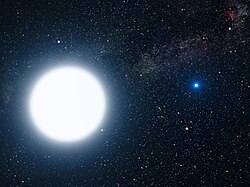In addition to isolated stars, a multi-star system can consist of two or more gravitationally bound stars that orbit around each other. The most common multi-star system is a binary star, but systems of three or more stars are also found. For reasons of orbital stability, such multi-star systems are often organized into hierarchical sets of co-orbiting binary stars.[63] Larger groups called star clusters also exist. These range from loose stellar associations with only a few stars, up to enormous globular clusters with hundreds of thousands of stars.
It has been a long-held assumption that the majority of stars occur in gravitationally bound, multiple-star systems. This is particularly true for very massive O and B class stars, where 80% of the systems are believed to be multiple. However the portion of single star systems increases for smaller stars, so that only 25% of red dwarfs are known to have stellar companions. As 85% of all stars are red dwarfs, most stars in the Milky Way are likely single from birth.[64]
Stars are not spread uniformly across the universe, but are normally grouped into galaxies along with interstellar gas and dust. A typical galaxy contains hundreds of billions of stars, and there are more than 100 billion (1011) galaxies in the observable universe.[65] While it is often believed that stars only exist within galaxies, intergalactic stars have been discovered.[66] Astronomers estimate that there are at least 70 sextillion (7×1022) stars in the observable universe.[67]
The nearest star to the Earth, apart from the Sun, is Proxima Centauri, which is 39.9 trillion (1012) kilometres, or 4.2 light-years away. Light from Proxima Centauri takes 4.2 years to reach Earth. Travelling at the orbital speed of the Space Shuttle (5 miles per second—almost 30,000 kilometres per hour), it would take about 150,000 years to get there.[68] Distances like this are typical inside galactic discs, including in the vicinity of the solar system.[69] Stars can be much

closer to each other in the centres of galaxies and in globular clusters, or much farther apart in galactic halos.
Due to the relatively vast distances between stars outside the galactic nucleus, collisions between stars are thought to be rare. In denser regions such as the core of globular clusters or the galactic center, collisions can be more common.[70] Such collisions can produce what are known as blue stragglers. These abnormal stars have a higher surface temperature than the other main sequence stars with the same luminosity in the cluster .



0 comments:
Post a Comment